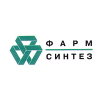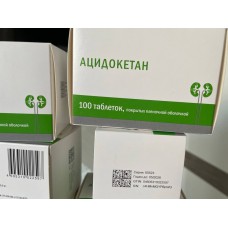Expiration date: 05/2026
Composition
1 tablet contains:
Active ingredients
Isoleucine alpha-ketoanalog (calcium ketoisoleucine) 67.0 mg
Leucine alpha-ketoanalog (calcium ketoleucine) 101.0 mg
Phenylalanine alpha-ketoanalog (ketophenylalanine calcium monohydrate) 68.0 mg
Valine alpha-ketoanalog (calcium ketovalin) 86.0 mg
Methionine alpha-hydroxyanalog (calcium hydroxymethionine) 59.0 mg
Lysine monoacetate 105.0 mg
Threonine 53.0 mg
Tryptophan 23.0 mg
Histidine 38.0 mg
Tyrosine 30.0 mg
Auxiliary substances
Corn starch 49.0 mg
Crospovidone 6.0 mg
Talc 19.57 mg
Colloidal silicon dioxide 4.4 mg
Magnesium stearate 15.0 mg
Macrogol 6000 12.8 mg
Povidone K30 38.2 mg
Tablet shell
Finished water-soluble film shell 25.0 mg
OPADRY® II, 85F220258, YELLOW
Crosslinked copolymer of Polyvinyl alcohol and Polyethylene glycol 40,000%
Talcum powder 27,500%
Titanium dioxide 20,818%
Quinoline yellow aluminum varnish 4,127%
Mono, di-glycerides 4,000%
Polyvinyl alcohol 3,500%
Sunset yellow 0.047%
Indigo carmine aluminum lacquer 0.008%
Description of the dosage form
Oblong, biconvex tablets, coated with a yellow color.
Pharmacokinetics
The plasma kinetics of amino acids and their incorporation into metabolic pathways have been well studied. Absorption processes in uremic patients taking amino acids do not seem to lead to a violation of their plasma concentrations, i.e. absorption is not impaired. Changes in plasma concentrations are likely to occur in the stages following the absorption of amino acids; they are detected at an early stage of the disease.
Plasma concentrations of ketoacids in healthy volunteers increase within 10 minutes after oral administration. Individual concentrations of ketoacids increase up to five times to the initial ones, maximum plasma concentrations are reached within 20-60 minutes, after 90 minutes, concentrations return to the initial ones. Thus, absorption from the gastrointestinal tract is very fast. The simultaneous increase in plasma concentrations of ketoacids and corresponding amino acids indicates a high rate of transamination. Due to the presence of physiological ways of ketoacid utilization in the body, exogenous ketoacids seem to be rapidly integrated into metabolic cycles. Ketoacids undergo the same catabolism pathways as regular amino acids. There has been no separate study of ketoacid excretion.
Pharmacodynamics
Ketoanalogs of amino acids are used in renal insufficiency as a nutrient.
The drug ensures the intake of essential amino acids into the body with minimal nitrogen intake.
After absorption, keto and hydroxy acids can be transaminated to form the corresponding essential amino acids, while the amino group is transferred from the interchangeable amino acids. Due to the reuse of the amino group, the formation of urea slows down and the accumulation of uremic toxins decreases. Keto and hydroxy acids do not cause hyperfiltration in the remaining nephrons. Keto-containing supplements have a positive effect on renal hyperphosphatemia and secondary hyperparathyroidism. Moreover, it is possible to improve the course of osteodystrophy. The use of the drug Acidoketan together with a diet with a very low protein content allows you to reduce nitrogen intake, while avoiding undesirable phenomena due to malnutrition and insufficient protein intake from food.
Indications
Prevention and treatment in adults and children from 3 years of age of disorders caused by pathological protein metabolism in chronic renal failure, with simultaneous observance of a low—protein diet not exceeding the amount of protein per day in adults 40 g, in children from 3 to 10 years – 1.4-0.8 g / kg of body weight per day, from 10 years — 1-0.6 g / kg of body weight per day. The glomerular filtration rate (GFR) in such patients, as a rule, does not exceed 25 ml/min.
Contraindications
Increased sensitivity to the components of the drug; impaired amino acid metabolism; hypercalcemia. Patients with hereditary phenylketonuria should take into account that the drug contains phenylalanine.
Use during pregnancy and lactation
There are no clinical data on the use of Acidoketan in pregnant women. In preclinical studies, direct or indirect harm to the course of pregnancy, embryophetal development, childbirth and postnatal development has not been found. During pregnancy, the drug should be used with caution. There is no experience of use during breastfeeding. If treatment with Acidoketan is necessary during breastfeeding, then breastfeeding should be discontinued.
Method of administration and dosage
Advertisement
For oral administration.
Adults and children from 3 years of age, one tablet per 5 kg of body weight per day or 0.1 g / kg of body weight per day. The usual dose for an adult (body weight 70 kg) is 4-8 tablets 3 times a day (whole) with meals. Ingestion with food improves absorption and metabolism to the appropriate amino acids.
Duration of use: the drug is used until the GFR does not exceed 25 ml / min, and the patient follows a low-protein diet containing no more than 40 g of protein per day (in adults).
The recommended protein content in food for children from 3 to 10 years old is 1.4–0.8 g / kg of body weight per day, for children from 10 years old — 1.0–0.6 g / kg of body weight per day.
Side effects
Undesirable side effects are grouped by organs and frequency of occurrence. The frequency was defined as: very often >10%, often 1-10%, infrequently 0.1–1%, rarely 0.01–0.1%, very rarely <0.01%, the frequency is unknown (it is impossible to estimate based on available data).
From the side of metabolism and nutrition: very rarely — hypercalcemia.
It is possible to develop allergic reactions to the components of the drug.
In this case, it is recommended to reduce the dose of vitamin D. If hypercalcemia persists, the dose of Acidoketan, as well as other sources of calcium, should be reduced.
See the section "Interactions with other medicines".
Interaction
Advertisement
Concomitant use with calcium medications can lead to hypercalcemia or exacerbate it.
In order not to disrupt absorption in the intestine, the drug should not be taken together with drugs capable of forming difficult-to-dissolve compounds with calcium (for example, tetracyclines, quinolone derivatives such as ciprofloxacin and norfloxacin; iron, fluorine and estramustine preparations).
At least a 2‑hour interval should be maintained between taking Acidoketan and such drugs.
Sensitivity to cardiac glycosides, and, consequently, the risk of arrhythmias, increases with increasing serum calcium concentration (see the section "Side effects").
As the uremic symptoms decrease under the influence of the drug, it is necessary to reduce the dose of prescribed aluminum hydroxide. The serum concentration of phosphates should be monitored.
Overdose
No overdose cases have been reported.
Special instructions
It is necessary to regularly monitor the serum calcium concentration. It is necessary to ensure sufficient calorie content of food. When used simultaneously with aluminum hydroxide, it is necessary to monitor the serum concentration of phosphates (see the section "interaction with other drugs").
The impact on the performance of potentially dangerous activities that require special attention and quick reactions
Acidoketan has no effect on the ability to drive vehicles and engage in other potentially dangerous activities that require increased concentration and speed of psychomotor reactions.
Release form
Film-coated tablets.
Primary packaging of a medicinal product
10, 20 or 24 tablets each in a contour cell package made of polyvinyl chloride film and aluminum printed lacquered foil.
50 or 100 tablets each in a polyethylene polymer jar with a lid stretched with the control of the first opening. Labels are pasted on cans.
Secondary packaging of a medicinal product
10 contour cell packages (10 tablets in a blister), 5 contour cell packages (20 tablets in a blister) or 4 contour cell packages (24 tablets in a blister) together with the instructions for use are placed in a pack of cardboard for consumer packaging. The packs are placed in a group package.
1 jar together with the instructions for use is placed in a pack of cardboard for consumer packaging. The packs are placed in a group package.
From 2 to 100 cans with an equal number of instructions are placed in a group package — a corrugated cardboard box (for hospitals).
Conditions of release from pharmacies
They are released by prescription.
Storage conditions
In a place protected from light at a temperature not exceeding 25 °C.
Keep out of reach of children.
Expiration date
3 years.
Do not use after the expiration date indicated on the package.
Acidoketan
(Ketoanalogues
of
aminoacids)
100
tablets
- Brand: PharmSintez

- Availability:
in stock
Categories:
-
$24.00

